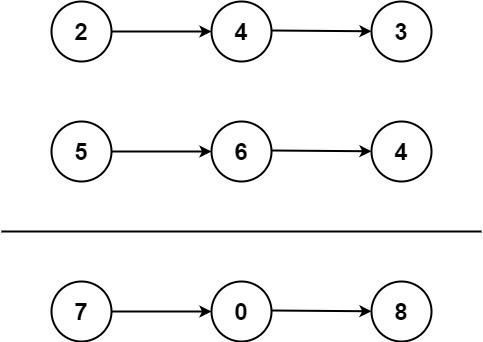代码拉取完成,页面将自动刷新
同步操作将从 doocs/leetcode 强制同步,此操作会覆盖自 Fork 仓库以来所做的任何修改,且无法恢复!!!
确定后同步将在后台操作,完成时将刷新页面,请耐心等待。
给你两个 非空 的链表,表示两个非负的整数。它们每位数字都是按照 逆序 的方式存储的,并且每个节点只能存储 一位 数字。
请你将两个数相加,并以相同形式返回一个表示和的链表。
你可以假设除了数字 0 之外,这两个数都不会以 0 开头。
示例 1:

输入:l1 = [2,4,3], l2 = [5,6,4] 输出:[7,0,8] 解释:342 + 465 = 807.
示例 2:
输入:l1 = [0], l2 = [0] 输出:[0]
示例 3:
输入:l1 = [9,9,9,9,9,9,9], l2 = [9,9,9,9] 输出:[8,9,9,9,0,0,0,1]
提示:
[1, 100] 内0 <= Node.val <= 9# Definition for singly-linked list.
# class ListNode:
# def __init__(self, val=0, next=None):
# self.val = val
# self.next = next
class Solution:
def addTwoNumbers(self, l1: ListNode, l2: ListNode) -> ListNode:
dummy = ListNode()
carry, cur = 0, dummy
while l1 or l2 or carry:
s = (0 if not l1 else l1.val) + (0 if not l2 else l2.val) + carry
carry, val = divmod(s, 10)
cur.next = ListNode(val)
cur = cur.next
l1 = None if not l1 else l1.next
l2 = None if not l2 else l2.next
return dummy.next
/**
* Definition for singly-linked list.
* public class ListNode {
* int val;
* ListNode next;
* ListNode() {}
* ListNode(int val) { this.val = val; }
* ListNode(int val, ListNode next) { this.val = val; this.next = next; }
* }
*/
class Solution {
public ListNode addTwoNumbers(ListNode l1, ListNode l2) {
ListNode dummy = new ListNode(0);
int carry = 0;
ListNode cur = dummy;
while (l1 != null || l2 != null || carry != 0) {
int s = (l1 == null ? 0 : l1.val) + (l2 == null ? 0 : l2.val) + carry;
carry = s / 10;
cur.next = new ListNode(s % 10);
cur = cur.next;
l1 = l1 == null ? null : l1.next;
l2 = l2 == null ? null : l2.next;
}
return dummy.next;
}
}
/**
* Definition for singly-linked list.
* struct ListNode {
* int val;
* ListNode *next;
* ListNode() : val(0), next(nullptr) {}
* ListNode(int x) : val(x), next(nullptr) {}
* ListNode(int x, ListNode *next) : val(x), next(next) {}
* };
*/
class Solution {
public:
ListNode* addTwoNumbers(ListNode* l1, ListNode* l2) {
ListNode* dummy = new ListNode();
int carry = 0;
ListNode* cur = dummy;
while (l1 || l2 || carry) {
int s = (l1 ? l1->val : 0) + (l2 ? l2->val : 0) + carry;
carry = s / 10;
cur->next = new ListNode(s % 10);
cur = cur->next;
l1 = l1 ? l1->next : nullptr;
l2 = l2 ? l2->next : nullptr;
}
return dummy->next;
}
};
/**
* Definition for singly-linked list.
* function ListNode(val, next) {
* this.val = (val===undefined ? 0 : val)
* this.next = (next===undefined ? null : next)
* }
*/
/**
* @param {ListNode} l1
* @param {ListNode} l2
* @return {ListNode}
*/
var addTwoNumbers = function(l1, l2) {
const dummy = new ListNode();
let carry = 0;
let cur = dummy;
while (l1 || l2 || carry) {
const s = (l1?.val || 0) + (l2?.val || 0) + carry;
carry = Math.floor(s / 10);
cur.next = new ListNode(s % 10);
cur = cur.next;
l1 = l1?.next;
l2 = l2?.next;
}
return dummy.next;
};
/**
* Definition for singly-linked list.
* public class ListNode {
* public int val;
* public ListNode next;
* public ListNode(int val=0, ListNode next=null) {
* this.val = val;
* this.next = next;
* }
* }
*/
public class Solution {
public ListNode AddTwoNumbers(ListNode l1, ListNode l2) {
ListNode dummy = new ListNode();
int carry = 0;
ListNode cur = dummy;
while (l1 != null || l2 != null || carry != 0) {
int s = (l1 == null ? 0 : l1.val) + (l2 == null ? 0 : l2.val) + carry;
carry = s / 10;
cur.next = new ListNode(s % 10);
cur = cur.next;
l1 = l1 == null ? null : l1.next;
l2 = l2 == null ? null : l2.next;
}
return dummy.next;
}
}
/**
* Definition for singly-linked list.
* type ListNode struct {
* Val int
* Next *ListNode
* }
*/
func addTwoNumbers(l1 *ListNode, l2 *ListNode) *ListNode {
dummy := &ListNode{}
carry := 0
cur := dummy
for l1 != nil || l2 != nil || carry != 0 {
s := carry
if l1 != nil {
s += l1.Val
}
if l2 != nil {
s += l2.Val
}
carry = s / 10
cur.Next = &ListNode{s % 10, nil}
cur = cur.Next
if l1 != nil {
l1 = l1.Next
}
if l2 != nil {
l2 = l2.Next
}
}
return dummy.Next
}
# Definition for singly-linked list.
# class ListNode
# attr_accessor :val, :next
# def initialize(val = 0, _next = nil)
# @val = val
# @next = _next
# end
# end
# @param {ListNode} l1
# @param {ListNode} l2
# @return {ListNode}
def add_two_numbers(l1, l2)
dummy = ListNode.new()
carry = 0
cur = dummy
while !l1.nil? || !l2.nil? || carry > 0
s = (l1.nil? ? 0 : l1.val) + (l2.nil? ? 0 : l2.val) + carry
carry = s / 10
cur.next = ListNode.new(s % 10)
cur = cur.next
l1 = l1.nil? ? l1 : l1.next
l2 = l2.nil? ? l2 : l2.next
end
dummy.next
end
此处可能存在不合适展示的内容,页面不予展示。您可通过相关编辑功能自查并修改。
如您确认内容无涉及 不当用语 / 纯广告导流 / 暴力 / 低俗色情 / 侵权 / 盗版 / 虚假 / 无价值内容或违法国家有关法律法规的内容,可点击提交进行申诉,我们将尽快为您处理。